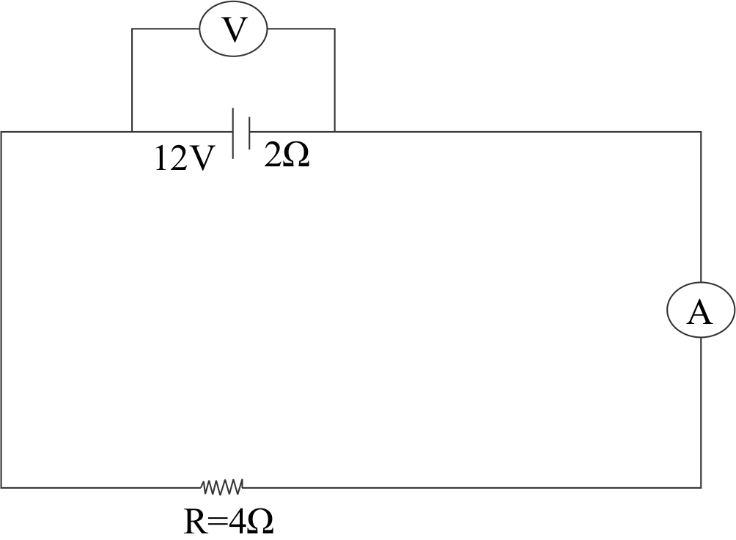
(a) The potential difference applied across a given resistor is altered so that the heat produced per second increases by a factor$9$. By what factor does the applied potential difference change?
(b) In the figure shown, an ammeter A and a resistor are $4\Omega $ connected to the terminals of the source. The emf of the source is $12V$ having an internal resistance $2\Omega $. Calculate the voltmeter and ammeter reading.

Answer
218.4k+ views
Hint: Electric potential could be a location-dependent amount that expresses the number of potential energy per unit of charge at such location. Once a Coulomb of charge (or any given quantity of charge) possesses a comparatively great quantity of potential energy at a given location, then that location is alleged to be a location of high electric potential. And equally, if a Coulomb of charge (or any given quantity of charge) possesses a comparatively tiny amount of potential energy at a given location, then that location is alleged to be a location of low electric potential.
Formula used:
Heat produced,
$ \Rightarrow H = \dfrac{{{V^2}t}}{R}$
Where, $H$is the heat produced, $V$is the voltage, $t$is the time, and $R$is the resistance.
Voltmeter,
$ \Rightarrow V = R - IR$
Where, $R$ is the resistance, and $I$ is the ammeter.
Complete step by Step Solution In this question, the heat is altered and that causes the heat produced by is $9$ times its initial.
So they are asking the factor for which the applied potential difference changes.
$\left( a \right)$. Suppose the original potential difference applied to be $V$ and the original heat produced will be $H$.
Then,
$ \Rightarrow H = \dfrac{{{V^2}t}}{R}$
Now the new potential difference will be $V'$ and the heat produced after the change is $H'$
Then, we can write the equation as
$ \Rightarrow H' = \dfrac{{{{V'}^2}t}}{R}$
According to the question statement,
$ \Rightarrow H' = 9H$
Now we will put the values of both the heat,
We get
$ \Rightarrow \dfrac{{{{V'}^2}t}}{R} = 9 \times \dfrac{{{V^2}t}}{R}$
On further solving this equation, we get
$ \Rightarrow {V'^2} = 9{V^2}$
Which implies,
$ \Rightarrow V' = 3V$
Therefore we can say that the potential difference is increased by a factor $3$.
$\left( b \right)$. Let us consider the voltmeter and the ammeter to be in an ideal state.
Here the total resistance $R$ will be equal to
$ \Rightarrow R = 4 + 2$
$ \Rightarrow 6\Omega $
Then the ammeter reading will be,
$ \Rightarrow I = \dfrac{V}{R}$
$ \Rightarrow I = \dfrac{{12}}{6}$
$ \Rightarrow 2A$
Hence the ammeter reading will be$2A$.
Now we will calculate the voltmeter required,
$ \Rightarrow V = R - IR$
Substituting the values, we get
$ \Rightarrow 12 - 2 \times 2$
$ \Rightarrow 12 - 4$
$ \Rightarrow 8V$
Therefore the voltmeter reading will be $8V$.
Note: Voltmeters and ammeters measure the voltage and current, severally, of a circuit. Some meters in automobile dashboards, digital cameras, cell phones, and tuner-amplifiers are voltmeters or ammeters.
Formula used:
Heat produced,
$ \Rightarrow H = \dfrac{{{V^2}t}}{R}$
Where, $H$is the heat produced, $V$is the voltage, $t$is the time, and $R$is the resistance.
Voltmeter,
$ \Rightarrow V = R - IR$
Where, $R$ is the resistance, and $I$ is the ammeter.
Complete step by Step Solution In this question, the heat is altered and that causes the heat produced by is $9$ times its initial.
So they are asking the factor for which the applied potential difference changes.
$\left( a \right)$. Suppose the original potential difference applied to be $V$ and the original heat produced will be $H$.
Then,
$ \Rightarrow H = \dfrac{{{V^2}t}}{R}$
Now the new potential difference will be $V'$ and the heat produced after the change is $H'$
Then, we can write the equation as
$ \Rightarrow H' = \dfrac{{{{V'}^2}t}}{R}$
According to the question statement,
$ \Rightarrow H' = 9H$
Now we will put the values of both the heat,
We get
$ \Rightarrow \dfrac{{{{V'}^2}t}}{R} = 9 \times \dfrac{{{V^2}t}}{R}$
On further solving this equation, we get
$ \Rightarrow {V'^2} = 9{V^2}$
Which implies,
$ \Rightarrow V' = 3V$
Therefore we can say that the potential difference is increased by a factor $3$.
$\left( b \right)$. Let us consider the voltmeter and the ammeter to be in an ideal state.
Here the total resistance $R$ will be equal to
$ \Rightarrow R = 4 + 2$
$ \Rightarrow 6\Omega $
Then the ammeter reading will be,
$ \Rightarrow I = \dfrac{V}{R}$
$ \Rightarrow I = \dfrac{{12}}{6}$
$ \Rightarrow 2A$
Hence the ammeter reading will be$2A$.
Now we will calculate the voltmeter required,
$ \Rightarrow V = R - IR$
Substituting the values, we get
$ \Rightarrow 12 - 2 \times 2$
$ \Rightarrow 12 - 4$
$ \Rightarrow 8V$
Therefore the voltmeter reading will be $8V$.
Note: Voltmeters and ammeters measure the voltage and current, severally, of a circuit. Some meters in automobile dashboards, digital cameras, cell phones, and tuner-amplifiers are voltmeters or ammeters.
Recently Updated Pages
Young’s Double Slit Experiment Derivation Explained

Wheatstone Bridge Explained: Working, Formula & Uses

Chemical Properties of Hydrogen - Important Concepts for JEE Exam Preparation

JEE General Topics in Chemistry Important Concepts and Tips

JEE Atomic Structure and Chemical Bonding important Concepts and Tips

JEE Amino Acids and Peptides Important Concepts and Tips for Exam Preparation

Trending doubts
JEE Main 2026: Application Form Open, Exam Dates, Syllabus, Eligibility & Question Papers

Derivation of Equation of Trajectory Explained for Students

Hybridisation in Chemistry – Concept, Types & Applications

Understanding the Angle of Deviation in a Prism

Understanding Collisions: Types and Examples for Students

Understanding Atomic Structure for Beginners

Other Pages
JEE Advanced Marks vs Ranks 2025: Understanding Category-wise Qualifying Marks and Previous Year Cut-offs

How to Convert a Galvanometer into an Ammeter or Voltmeter

Understanding Centrifugal Force in Physics

Ideal and Non-Ideal Solutions Explained for Class 12 Chemistry

Degree of Dissociation: Meaning, Formula, Calculation & Uses

Understanding Electromagnetic Waves and Their Importance




